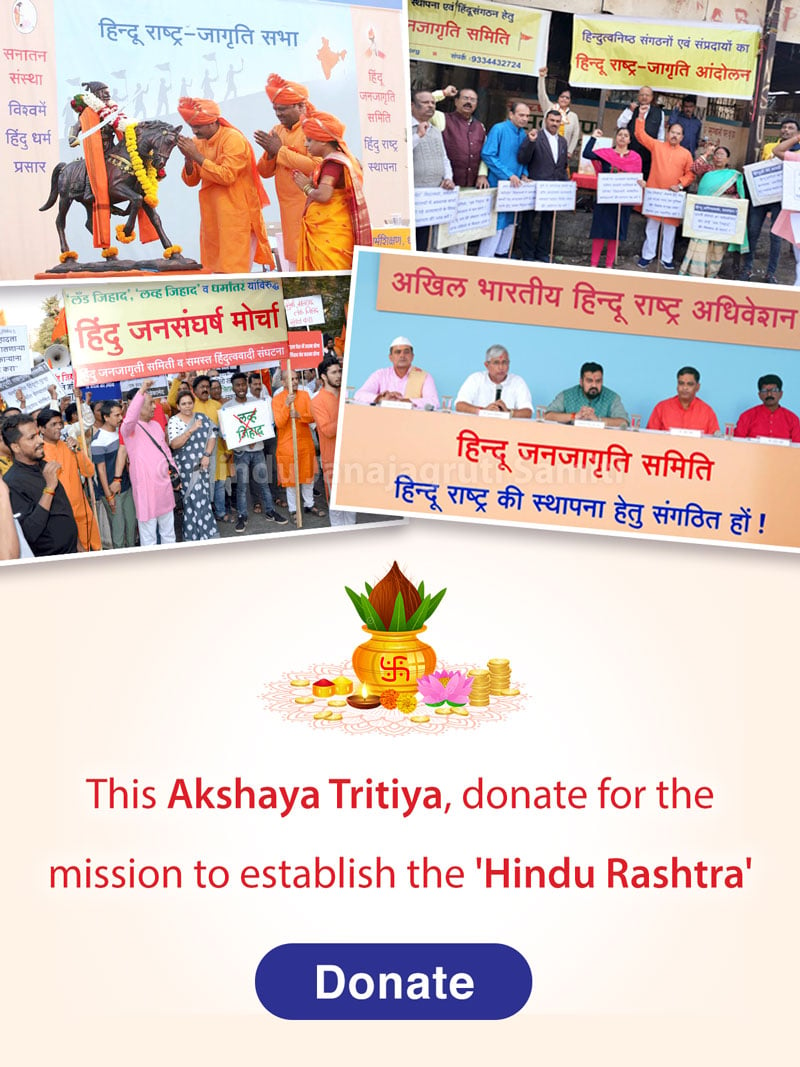In this article, we will obtain knowledge about Shri Datta, also known as Shri Gurudev Datta or Datta Guru.
1. Names of Shri Datta & their meanings
A. Datta
Datta is one who has been bestowed with the spiritual experience of the nirguṇ (Nonmaterialised), meaning, the one who has been given the experience that the ‘Self’ is Brahman (God in His aspect as the Creator of the universe) or mukta (Liberated) self or the soul.
B. Avadhut
Some of the origins and meanings of the word Avadhut (अवधूत) are
1. A (अ) = One who constantly experiences Anand (note) (Bliss) (आनंदे वर्तते नित्यम ।).
Va (व) = One who constantly lives in the present (वर्तमानेन वर्तते ।).
Dhu (धू) = One whose (spiritual) ignorance has been dispelled with spiritual knowledge, meaning, the one who emancipates all. (ज्ञाननिर्धूत वल्याण: ।).
T (त) = One who has destroyed all ignorance by contemplating on the Absolute Principle (तत्त्वचिन्तनधूत येन ।)
2. In the Avadhutopanishad, ‘Avadhut’ has been described as follows.
A (अ) = This syllable stands for aksharatva. Avadhut is the one who has had the sakshatkar (Self-realisation) of Aksharbrahman (Brahman Principle in the alphabet). Aksharatva means the ability to complete a task successfully.
Va (व) = This word is derived from ‘Vareṇyatva’, that is, pinnacle of greatness or Absoluteness.
Dhu (धू) = This refers to one who is freed from all types of bondage, is Liberated, and one who does not function with any title or restrictions.
Ta (त) = This represents the immortal statement ‘तत्त्वमसि’, meaning, ‘You are that Principle’ (One of the four immortal statements from the Upanishads (These are a class of philosophical writings attached to the Brahman section of Vedas; their aim is exposition of the secret meaning of the Vedas (note) and are regarded as the source of Vedant philosophy)).
In brief, the title of Avadhut is given to a great Saint who remains engrossed in self-realisation
3. सर्वान् प्रकृतिविकारान् अवधुनोतीत्यवधूतः ।
Meaning : That which cleanses or destroys Sattva, Raja and Tama is Avadhut; this is how He is described according to the Siddhasiddhantapaddhati (6.1), a Holy text by Gorakshanath.
4. Devotees of Deity Datta proclaim – ‘‘अवधूत चिन्तन श्री गुरुदेव दत्त ।’’
Meaning : ‘Avadhut’ is a devotee. Shri Gurudev Datta is one who is ever engrossed in contemplation of devotees, that is, He is the well-wisher of devotees.
C. Dattatreya
This word is derived from Datta and Atreya. The meaning of ‘Datta’ has already been explained above. ‘Atreya’ means the son of Sage Atri.
D. Digambar
Is the principle which gives company to an embodied soul till it gets Final Liberation in the radiance of the sky, i.e. beyond all the directions.
E. Shripad
‘Shri’ is the never-ending principle of God. The principle that takes an embodied soul to that principle of God or to the Holy Feet of ‘Shri’ principle, is the Datta principle in Shripad.
F. Vallabh
The Datta principle in the form of Vallabh protects the Universe from the circular-shaped negative energies that create fear psychosis, and thus protects the embodied souls. – (Pujya) Ms. Anjali Gadgil
2. History of Deity Datta’s birth
Once Brahma, Vishṇu and Mahesh together set out to test the purity of Anasuya, Sage Atri’s wife. Due to her purity, three sons were born to her; one each from the fractions of Brahma, Vishṇu and Mahesh. Deity Datta was born from the fraction of Deity Vishṇu. Most people know this metaphorical story from the Puraṇas (The eighteen sacred Holy texts compiled by Sage Vyas). From the spiritual perspective, the implied meaning of ‘Atri’ is as follows.
‘A’ (अ) means ‘absent’ (‘A’ is indicative of negation) and ‘tri’ (त्रि) means ‘tripuṭi (Triad of doer of the karma, the karma and the act of performing the karma that are inter-related)’. Hence, ‘atri’ is one who is devoid of triputi such as the states of wakefulness-dream-deep sleep, Sattva-Raja- Tama (note) or one who meditates-goal-meditation. The intellect of such an ‘atri’ is without any asuya, that is, desire-anger and the six types of action, and is thus pure. This pure intellect itself is called ‘anasuya’. Deity Datta was born from the sankalpa (Resolve) of such pure intellect.
3. Incarnations of Deity Datta
In the historical age, three incarnations of Deity Datta assumed were Shripad Shrivallabh, Shri Nrusinha Sarasvati and Manikprabhu. Shripad Shrivallabh was the first incarnation of Deity Datta. Shri Nrusinha Sarasvati was His second and Manikprabhu the third incarnation. The fourth incarnation was Shri Swami Samarth. These four are absolute incarnations but there are several partial incarnations. Shri Vasudevanand Sarasvati (Tembeswami) is included in them. Jains worship Dattatreya in the form of Neminath while Muslims remain in the attire of a mendicant. A mendicant is always a devotee of Lord Datta.
4. Implied meaning of Deity Datta’s family
If you look closely at the appearance of Deity Datta, you will notice that Diety Datta is never alone. A cow is depicted behind Him, while four dogs are seen standing or sitting attentively around Him. We can also notice that Deity Datta stands under a huge fig tree. Let us understand what these three aspects convey.
A. The cow (standing behind Deity Datta) : The earth and Kamadhenu (Divine wish-fulfilling cow)
B. The four dogs : The four Vedas
C. The Holy fig tree (Oudumbar) : The venerable form of Deity Datta; because it contains a greater proportion of the Datta Principle
Reference : Sanatan’s Holy Text ‘Datta’

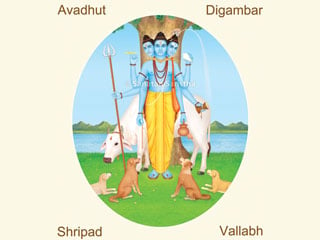
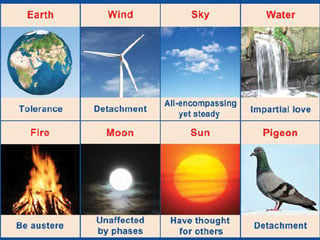 24 Gurus of Dattatreya - Gurus and subordinate Gurus
24 Gurus of Dattatreya - Gurus and subordinate Gurus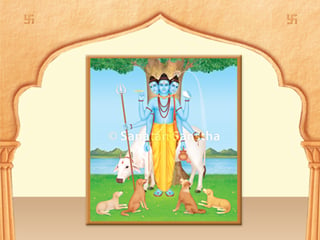 Science of Spirituality underlying the Idol of Shri Datta
Science of Spirituality underlying the Idol of Shri Datta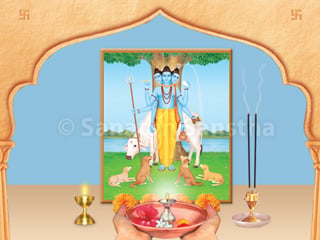 Worship of Shri Datta and Dattatreya puja
Worship of Shri Datta and Dattatreya puja Rangoli designs associated with Shri Datta Principle
Rangoli designs associated with Shri Datta Principle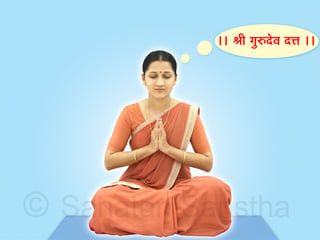 What is the significance of chanting Shri Gurudev Datta?
What is the significance of chanting Shri Gurudev Datta?